一、前言
1.HTML中的三种布局方式:
- 标准流(普通流):网页中默认的布局方式,即顺序布局
- 浮动:float
- 定位:position
2.position属性的作用方式:
- 给position属性设置相应的值,可使元素脱离正常的标准流,并且可以使用top、right、left、bottom属性对元素进行定位,还可以使用z-index属性对元素的层叠顺序进行更改
- position的五个属性值:static、relative、absolute、fixed、inherit
为方便,top、right、left、bottom属性简写为TRLB
二、介绍position的五个属性值
1.static:默认值,无定位
- 元素显示在正常的标准流中,并且忽略TRLB以及z-index属性的设置
- 相当于没有设置position属性
2.absolute:生成绝对定位元素
- 可以使用TRLB对元素进行定位,也可使用z-index更改元素的层叠顺序
- 相对于 static 定位以外的第一个父元素进行定位,脱离了正常的标准流,并且不占用标准流空间
举个栗子:
将div标签的position设置为absolute
<!DOCTYPE html> <html lang="en"> <head> <meta charset="UTF-8"> <title>absolute</title> <style type="text/css"> *{ margin: 0px; padding: 0px; } .absolute{ width: 100px; height: 100px; border: 1px solid red; position: absolute; top: 0px; left: 0px; } </style> </head> <body> <p>你好</p> <div class="absolute"></div> </body> </html>
浏览器显示:

通过页面显示我们发现,设置为absolute的绝对定位元素div,不顾处于标准流中的p标签的存在,仍然显示在了top:0px; left:0px;位置,
从中我们也可以看出绝对定位元素脱离了正常的标准流
3.relative:生成相对定位元素
- 可以使用TRLB对元素进行定位,也可使用z-index更改元素的层叠顺序
- 虽然该元素的位置发生了移动,但相对定位元素仍然处于正常的标准流中,所占据的空间是未生成定位元素之前它所占据的空间,而不是移动之后所占据的空间
- 使用TRLB对元素进行定位时,不能破坏也无法破坏正常的标准流
- 相对于原来正常时的位置进行定位
举个栗子:
将div标签的position设置为relative
<!DOCTYPE html> <html lang="en"> <head> <meta charset="UTF-8"> <title>relative</title> <style type="text/css"> *{ margin: 0px; padding: 0px; } .relative{ width: 100px; height: 100px; border: 1px solid red; position: relative; top: 0px; left: 0px; } </style> </head> <body> <p>你好</p> <div class="relative"></div> </body> </html>
浏览器显示:

我们发现,设置为relative的相对定位元素div,受标准流中的p标签的约束,显示在了p标签的下方,因为它是相对于在标准流中原来的位置进行定位的.
通过下面两个栗子来对比相对定位和绝对定位
绝对定位absolute
<div style=" 240px; height: auto; border: solid 1px black;"> <div style=" 80px; height: 80px; background-color: red; position: absolute; margin: 0 auto;"></div> </div>
相对定位relative
<div style=" 240px; height: auto; border: solid 1px black;"> <div style=" 80px; height: 80px; background-color: red; position: relative; margin: 0 auto;"></div> </div>
我们发现:1. 相对定位元素可以为父元素撑起高度,而绝对定位元素却会造成父元素塌陷,也说明了相对定位元素没有脱离标准流,而绝对定位元素脱离了标准流。
2.未脱离标准流的元素可以通过设置margin-left和margin-right为auto,来使块级元素水平居中。
4.fixed:也是生成绝对定位元素
- 可以使用TRLB对元素进行定位,也可使用z-index更改元素的层叠顺序
- 相对于浏览器窗口进行定位,脱离了正常的标准流,并且不占用标准流空间
- 当页面滚动时,元素固定不动
举个栗子:
给position设置为relative的div标签,加一个position设置为relative的父标签,观察fixed是否受具有position的父标签影响,作为对比我们再加上一个属性值为absolute的div标签
<!DOCTYPE html> <html lang="en"> <head> <meta charset="UTF-8"> <title>fixed</title> <style type="text/css"> *{ margin: 0px; padding: 0px; } .fixed{ width: 100px; height: 100px; border: 1px solid red; position: fixed; top: 0px; left: 0px; } .absolute{ width: 100px; height: 100px; border: 1px solid blue; position: absolute; top: 0px; left: 0px; } .pre{ width: 200px; height: 200px; border: 1px solid black; position: relative; top: 100px; left: 100px; } </style> </head> <body> <div class="pre"> <div class="fixed"></div> <div class="absolute"></div> </div> </body> </html>
网页显示:

我们发现,属性值为fixed的子标签并不受具有position属性的父标签影响,脱离了来父标签的约束,相对于浏览器窗口显示在top:0px; left:0px;位置.
而属性值为absolute的子标签却受着具有position属性的父标签约束,相对于position为relative的父元素显示在了top:0; left:0;位置,这也是fixed与absolute的一个重要区别。
5.inherit:继承
- 从父标签继承position属性值
举个栗子:
对于父div标签我们设置position:fixed,对于子div标签我们设置position:inherit,观察子标签是否会继承父标签的position属性值
<!DOCTYPE html> <html lang="en"> <head> <meta charset="UTF-8"> <title>inherit</title> <style type="text/css"> *{ margin: 0px; padding: 0px; } .pre{ width: 200px; height: 200px; border: 1px solid black; position: fixed; top: 100px; left: 100px; } .inherit{ width: 100px; height: 100px; border: 1px solid red; position: inherit; top: 0px; left: 0px; } </style> </head> <body> <div class="pre"> <div class="inherit"></div> </div> </body> </html>
浏览器显示:
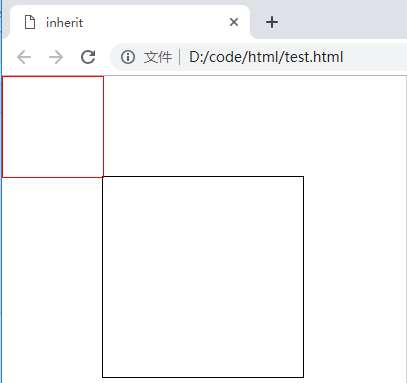
我们发现,子标签具有和父标签同样的position属性值---fixed,子标签的fixed使它显示在了相对于浏览器窗口进行定位的top:0px; left:0px;位置
三、总结与补充
1.关于relative的补充
- 通过上面介绍发现relative并未使元素脱离正常的标准流,因此元素仍受标准流的约束(包括其它元素以及自身的外边距和内边距)
- 而脱离了标准流(具有absolute,fixed属性值)的元素,则不受标准流的约束,不受其它元素内外边距的约束,但自身的内外边距会对自身产生约束
- 无论相对定位元素定位在哪里,它都一直占有原来位置上的文档流,而绝对定位元素真正的脱离了文档流,不再占用原来的位置
关于前两点举个栗子
给body标签设置内边距和外边距,观察相对定位元素和绝对定位元素的显示情况
<!DOCTYPE html> <html lang="en"> <head> <meta charset="UTF-8"> <title>inherit</title> <style type="text/css"> body{ margin: 10px; padding: 10px; } .relative{ width: 100px; height: 100px; border: 1px solid red; position: relative; top: 0px; left: 0px; } .absolute{ width: 100px; height: 100px; border: 1px solid black; position: absolute; top: 0px; left: 0px; } </style> </head> <body> <div class="relative"></div> <div class="absolute"></div> </body> </html>
网页显示:
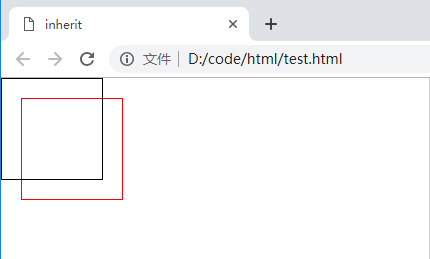
我们发现元素:<div class="relative"></div>受body标签内外边距的影响,显示在了元素:<div class="absolute"></div>的右下方
关于第三点再举个栗子
我们将中间的div设置为relative
<!DOCTYPE html> <html lang="en"> <head> <meta charset="UTF-8"> <title>z-index</title> <style type="text/css"> *{ margin: 0px; padding: 0px; } .yellow{ width: 100px; height: 100px; background-color: yellow; } .relative_red{ width: 100px; height: 100px; background-color: red; position: relative; left: 200px; } .black{ width: 100px; height: 100px; background-color: black; } </style> </head> <body> <div class="yellow"></div> <div class="relative_red"></div> <div class="black"></div> </body> </html>
网页显示:

为了对比,我们将中间div的relative改为absolute:

<!DOCTYPE html> <html lang="en"> <head> <meta charset="UTF-8"> <title>z-index</title> <style type="text/css"> *{ margin: 0px; padding: 0px; } .yellow{ width: 100px; height: 100px; background-color: yellow; } .absolute_red{ width: 100px; height: 100px; background-color: red; position: absolute; left: 200px; } .black{ width: 100px; height: 100px; background-color: black; } </style> </head> <body> <div class="yellow"></div> <div class="absolute_red"></div> <div class="black"></div> </body> </html>
网页显示:
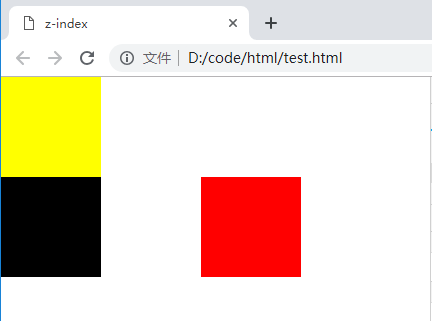
我们发现,设置position:relative的div在原来的文档流上,仍然占有空间,而设置position:absolute的div在文档流上不再占有空间
2.关于绝对定位元素的补充
- 使用position属性生成绝对定位元素后(position值为 absolute 或 fixed),该元素同时也会变成一个块状元素,无论它之前是什么类型
栗如:
未设置position的<span>标签
<span style=" 100px; height: 100px; background-color: red"></span>
尽管给它加了width和height属性,但它还是作为内联元素,width和height属性无效,所以网页显示空白
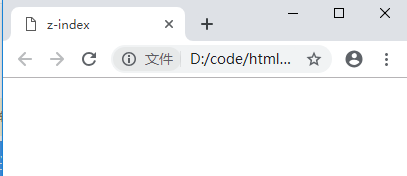
添加position:absolute生成绝对定位元素之后
<span style=" 100px; height: 100px; background-color: red;position: absolute;"></span>
<span>标签同时变成了块状元素
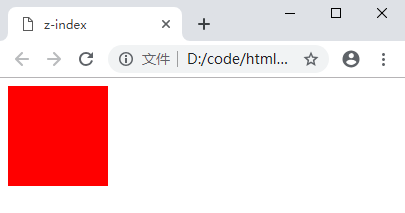
3.top,right,left,bottom属性
- top属性值是指,将元素定位到距离相对位置顶端的距离
- right属性值是指,定位到距离相对位置右端的距离
- left属性值是指,定位到距离相对位置左端的距离
- bottom属性值是指,定位到距离相对位置底端的距离
- 属性值都可为负数,表示朝反方向定位
4.z-index属性
因为先写的定位元素会被后写的定位元素覆盖,因此我们需要设置定位元素的堆叠顺序,是其按照我们想要的覆盖方式进行显示
- z-index属性用来设置元素的堆叠顺序,拥有更高堆叠顺序的元素总是会处于堆叠顺序较低的元素的前面。
- z-index属性仅能在具有定位属性的元素上奏效
- 当z-index为负值时该元素会被标准流中的元素覆盖
举个大栗子:
<!DOCTYPE html> <html lang="en"> <head> <meta charset="UTF-8"> <title>z-index</title> <style type="text/css"> *{ margin: 0px; padding: 0px; } .red{ width: 100px; height: 100px; background-color: red; position: absolute; top: 0px; left: 0px; z-index: 5; } .black{ width: 100px; height: 100px; background-color: black; position: absolute; top: 0px; left: 0px; z-index: 3; } .blue{ width: 100px; height: 100px; background-color: blue; position: absolute; top: 0px; right: 0px; z-index: -1; } .no-position-yellow{ width: 1500px; height: 1000px; background-color: yellow; } </style> </head> <body> <div class="no-position-yellow"></div> <div class="red"></div> <div class="black"></div> <div class="blue"></div> </body> </html>
网页显示:
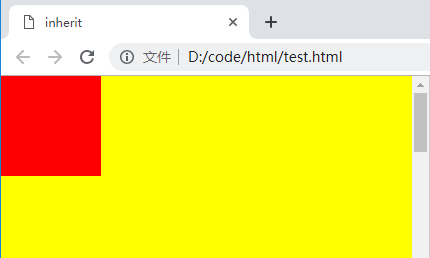
我们可以看到只有背景为红色和黄色的元素显示了,并且红色元素堆叠在黄色元素上方,因为黑色元素的z-index小于红色元素的z-index,而它们位置相同,因此红色元素将黑色元素完全覆盖了.
对于蓝色元素,因为他的z-index为负数,所以它直接被标准流中的黄色元素覆盖.
四、最后
我理解浅薄,如有错误或不足之处还请留言指出,十分感谢!

